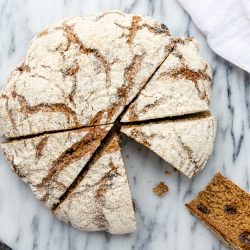Grains have been part of the human diet since we were hunter-gatherers—at least 14,000 years! We’re interested in old foodways at the Bakehouse and often use at least 100 years as a mental guideline for what constitutes old. At 14,000 years grains certainly make the cut-off.
Archaeologists recently found the earliest bread (around 14,000 years)—a mixture of wild einkorn wheat and a kind of root vegetable—at a site in northeastern Jordan. Ancient potato bread! This was a real surprise both because it’s amazing that it was preserved and because it was thought that at this time humans mainly ate grain in the form of porridge. Around 10,000 BCE humans started a process of domesticating grain and settling down from our nomadic lifestyle into villages. Bread making at this point would be less surprising.
![]() Although grains have been a major part of our diet prior to the dawn of civilization, today many of us have lost even the most basic connection to them. It’s not surprising. Baking and milling are actually two domestic activities that moved out of the household and into larger-scale production comparably early in human history. With all this time, the world has gotten very good at growing and milling cereal grains—to the point that most of us haven’t felt the need to know much about them. We could go to the store or mill and buy the flour we need at any time. Our supply has been very reliable and consistent, and as a result, most of us have lost knowledge of our grains. As the Bakehouse Grain Commission pursues our work on sourcing local grains and milling, we realized we should remind all of us of some basic information about grains.
Although grains have been a major part of our diet prior to the dawn of civilization, today many of us have lost even the most basic connection to them. It’s not surprising. Baking and milling are actually two domestic activities that moved out of the household and into larger-scale production comparably early in human history. With all this time, the world has gotten very good at growing and milling cereal grains—to the point that most of us haven’t felt the need to know much about them. We could go to the store or mill and buy the flour we need at any time. Our supply has been very reliable and consistent, and as a result, most of us have lost knowledge of our grains. As the Bakehouse Grain Commission pursues our work on sourcing local grains and milling, we realized we should remind all of us of some basic information about grains.
Our ultimate goal is to inspire some of you to mill your own grains at home, so that you can use freshly milled flour in your morning pancakes! It’s as easy as grinding coffee beans, and the flavor and nutritional difference is remarkable. On October 25th and 26th, Sue Becker (a home miller since the early 1990s, as well as educator and business owner) will be with us at BAKE! to host two classes about home milling. Make room on your kitchen counter for your own mill…move over Mr. Cuisinart!
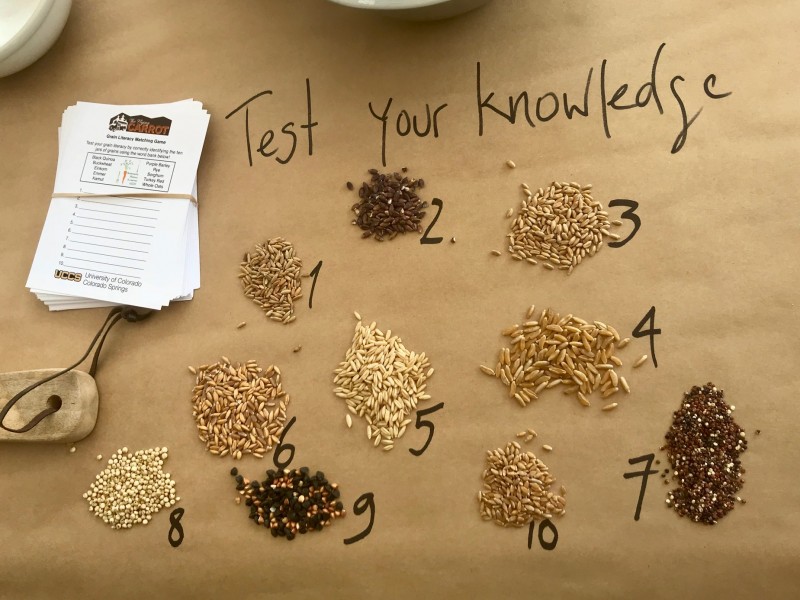
Here are some basic facts:
What are grains, or as they are sometimes called, cereals?
Grains are mainly grasses. Cereal grains are members of the grass family that produce edible seeds or kernels. Examples are wheat, rice, barley, corn, oats, and rye. Although flour to most Americans refers to wheat flour, that’s because wheat is the primary grain in the US. Flour is the powder created by grinding seeds, nuts, or roots.
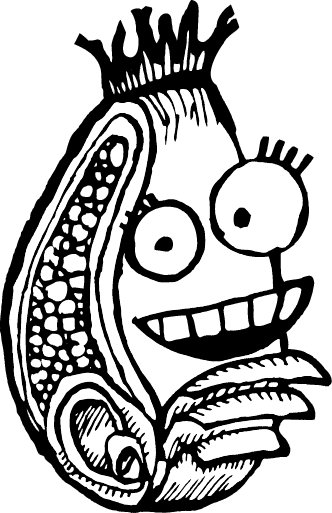
What is the structure of the edible seeds?
Most grain seeds have the same basic anatomy.
Chaff or hull: This is the dry, very thin protective membrane that covers the exterior of the seed for protection. We do not actually eat the chaff. Once the grain is harvested, the seeds are threshed to remove them from the stalk and release the chaff. Winnowing comes next which removes any remaining chaff. When we buy kernels to mill, this process has already been completed.
Some grains have an exterior called a hull. Hulls are much more stubborn than chaff and require some form of physical force to remove them. This is the case with barley and hence the term “pearled” barley. Barley has a hull, and it takes “pearling” to remove it.
The jargon around grains is well developed and can be confusing without a little education. Have you ever wondered why it’s called a wheat berry versus an oat groat? It’s all about whether the exterior is a chaff or a hull. Berries have chaffs and oats have hulls.
Bran: The next layer of a grain berry or groat is the bran, which many of us are super familiar with because of its high-fiber content. That’s not all that bran brings to the table. It’s high in vitamin B and iron, and has a good amount of protein and enzymes that help with digestion. When I learned about the enzymes, I wondered if some of our digestive issues around wheat might have to do with not getting these enzymes from the bran because we’re eating primarily white flour that has the bran removed. Nutritionists and doctors have often promoted eating bran for the fiber, but it also has other valuable nutritional qualities.
Germ: The germ is the smallest part of the kernel, only about 5 percent in terms of weight, but it contains the highest density of nutrients. Mostly it’s fatty acids and a very high amount of vitamin E, which is an effective antioxidant. The germ is removed from many of our store-bought flours because it can become rancid more quickly than the other components of a kernel, shortening the shelf life of the flour. For some purposes, shelf life is more important than nutrition or flavor.
Endosperm: is the largest part of the kernel. It is primarily starch and serves as the food for the plant. White wheat flour is the endosperm.
Whole wheat or whole rye or whole barley in its most correct form is the flour produced when the entire kernel of a grain is ground together and kept intact. In our country sometimes the descriptor “whole” is used but actually means that the white flour (the endosperm) is separated from the bran and the germ, and then some amount of bran and germ is added back in. The amount added in can vary by mill.
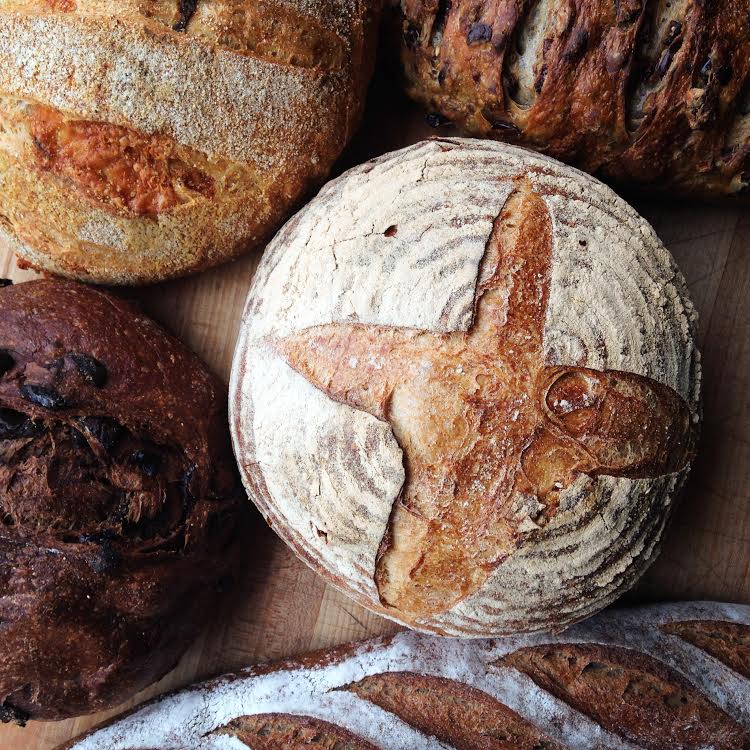
Storage and Milling
Grains are one of the few human foods that don’t have to be processed before storage, which makes them highly valuable. Remarkably, archaeologists have found stashes of ancient grain kernels that are thousands of years old and are still viable. Perhaps the resiliency of grains is one of the reasons they’ve been a part of our diet for such a long time. All they need is to be protected from moisture and infestation, which I’ll admit is not insignificant. The Bakehouse just lost 6,000 pounds of kernels at a mill because the grain developed a musty aroma and flavor from moisture.
We plan to write more fully about milling in the coming months, but for the purpose of relaying the most important basic information about grain, we think it’s good to know the difference between roller milling and stone milling.
Stone ground milling is an older form of milling in which two moving stones grind whole kernels of grain in between them. Humans, animals, water, wind, and now electricity can power the stones. One of the benefits of stone milling is that the entire kernel is ground together, meaning that the bran, germ, and endosperm all come into contact with one another. When this flour is left as is, not sifted after milling, it’s considered whole. If the miller decides to make it more refined by sifting what’s left, it still has some of the bran and germ in it because they were mixed with the endosperm during the milling process. This flour is more complex in its nutrition than what is produced by other methods, even when it is refined. Soon we will have a small stone mill at the Bakehouse. We’re looking forward to learning about milling effectively.
Roller milling is a more recent invention that allows us to mill more flour more quickly and efficiently, and it allows us to get highly refined flour. The result is the possibility of creating flour that is highly refined and only has the endosperm in it.
Two other elements of the milling process that are important for us all to know about are bleaching and aging.
First, bleaching whitens the flour, nothing else. It may not be an unhealthy process but also is not a necessary process. When bakers are working in the realm of art, and beauty and aesthetics as the primary criteria for success, then using bleached flour may be appealing, but it isn’t necessary.
Second is aging—as flours sit, they become oxidized and the enzymes inside change. When this happens, the quality of the flour in baking is more consistent and predictable, which professional bakers often prefer. Consistency certainly makes life easier. Aging can happen simply by allowing flour to sit after milling. Most artisan bakers think that three weeks is plenty of time to turn flour from “green” to aged. Not everyone wants to hold milled flour for three weeks, though—imagine the inventory space necessary! Millers came up with a chemical method of aging called bromation—they use the chemical potassium bromate, which has been identified as a carcinogen and banned in some parts of our country. It definitely is not necessary, and we recommend avoiding it. We avoid using any bromated flour at our bakery.
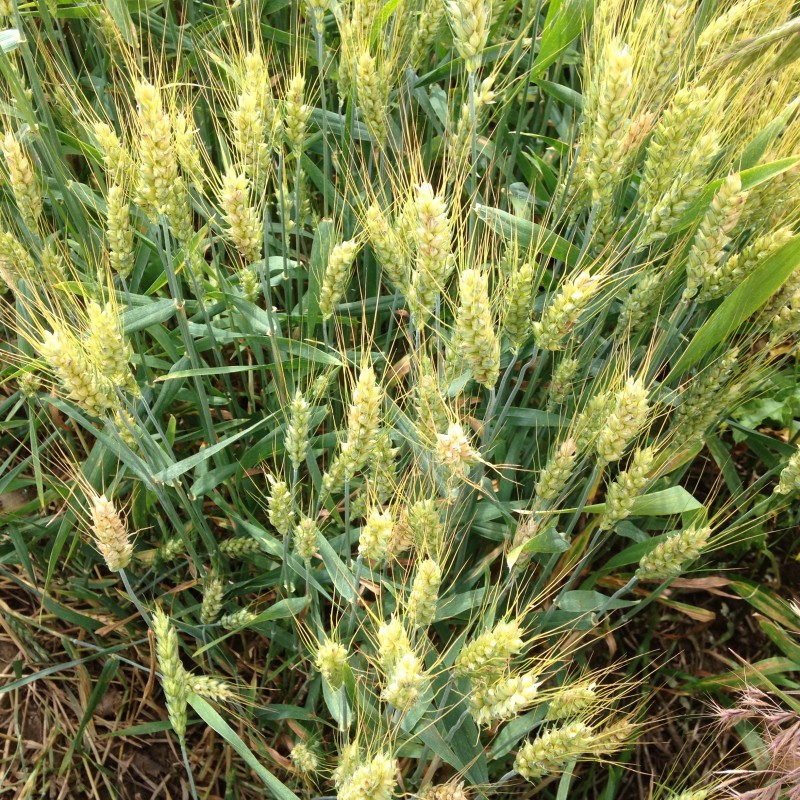
An Intro to Wheat! The Most Popular Grain
Wheat is the most popularly grown grain in the world. In recent years it accounted for fully one-third of the world’s cereal harvest. I imagine that there are many reasons for this, but from the perspective of a baker, I can say that it performs incredibly well in many baking contexts. It makes our lives easier.
Just one wheat?
No, there are many strains of wheat! Just like there are many different kinds of apples or grapes or basils, there are wide varieties of wheats. Some of them are in use today, and many are being brought back by interested farmers and bakers. They are referred to as heritage varieties. We can all expect to see more “named” wheats identified as ingredients in bakeries, on menus, and sold in stores. Examples of heritage grains are Red Fife and Turkey Red wheat, which we’re using in our Turkey Red Walnut bread. Understandably there’s been some confusion about this name with people wondering if there’s turkey meat in the loaf. Nope, it’s just the name of the actual strain of wheat we used. Just like other plants, these different wheats have different baking qualities and flavors.
Another group of named wheats are ancient varieties, which are being revived. Two common ones are emmer and einkorn. They are thought to be the original wheats of the ancient Middle East from which modern wheats were eventually evolved. We have been milling einkorn at the Bakehouse and using it fresh and whole in a scone. The flavor complexity—nutty, slightly sweet—immediately appealing.
Spelt and durum
These are two forms of wheat which are distinct types that have been used and named for years and perhaps more familiar to people. Durum wheat is the second most cultivated wheat in the world. It is a high-protein wheat most prevalent in southern Italy and commonly used in pasta production and some breads. It’s what we use in our sesame semolina bread. Spelt is also a member of the wheat family. It seems to have been developed around 5,000 BC. It’s the wheat we use in our Dinkelbrot. Dinkel means spelt in German.
What about the wheat we find in the grocery store?
Most of the time many of us are using unnamed, generic wheat. Bakers and millers characterize this wheat in the following three ways:
Hard/Soft: The difference between these is determined by their protein content. Hard wheat has a higher protein content, making it better for structure development and, therefore, bread baking. Soft wheat has a lower protein content and is more commonly used for more delicate baking, like cakes.
Winter/Spring: This is a reference to when the wheat is planted. Some varieties are planted in the early winter and are harvested in early spring, hence it’s called winter wheat. Spring wheat is planted in the spring and harvested in the summer.
Red/White: This descriptive is in reference to the color of the bran on the wheat berry.
How do people use these distinctions in conversation?
A baker may say that they are using a soft white winter wheat in their pie crust. Quite a mouthful and not as tasty as the actual pie! As consumers, we most often see the names bread flour, all-purpose flour, pastry flour, and cake flour. These names are indications of the protein content of the flour. Bread flour has the most at 12 percent or higher, and cake flour often has 7.5-8 percent protein. The protein content has the greatest impact on how the flour functions in baking, so it makes sense that we would want to know this when we’re purchasing the flour.
There is obviously much more to explore about grains and wheat. Expect to learn more in installment #2, as we reconnect with this ancient food source.
by Amy and the Bakehouse Grain Commission
She has been an avid food lover and baker since her childhood in Nova Scotia, Canada. After high school Amy moved to Cambridge, MA and received her bachelor’s degree from Harvard University. She then followed her passion for food and learned to cook and bake at L’ecole de Gastronomie Francaise at the Ritz Hotel in Paris, France as well as in Michigan restaurants. In 1999 she received her MBA from Columbia University.
Amy came to Zingerman’s Bakehouse when it opened in 1992 as one of the original bakers on the staff of eight. She soon became the first manager of the bread bakery, then the manager of the pastry kitchen and in 2000 she became a partner.
Amy has been working in the food world for over 20 years and is passionate about hands-on baking, teaching about baking and business, developing businesses and people. As well as teaching at BAKE! Amy presents for ZingTrain on our business practices. A few of the Bakehouse items she is personally responsible for developing are the Old School Apple Pie, Buenos Aires Brownies, and our Gingerbread Coffeecake. In addition to developing items, Amy is a promoter of classic bakery favorites from many cultures and has brought traditional standards to the Bakehouse such as Paris Brest, Hummingbird Cake, and Maple Cream Cookies.



